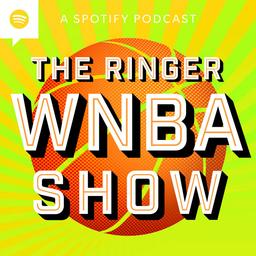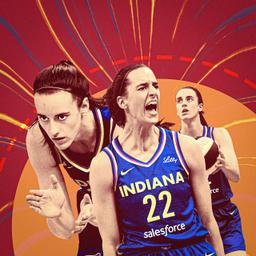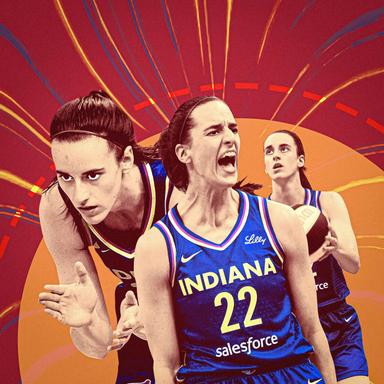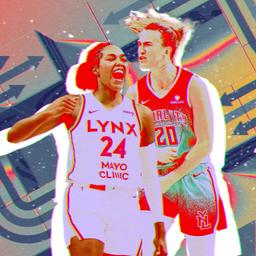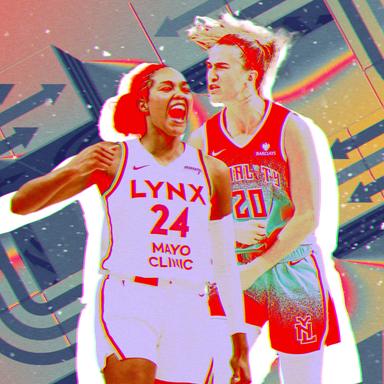The WNBA’s most anticipated regular season is turning out to be its most unpredictable.
Several of the teams that made win-now moves this past offseason are watching their best-laid plans implode, while the rebuilding Mystics and expansion Valkyries vie for playoff spots. Even Caitlin Clark’s logo 3, the impossible shot she has made feel inevitable, has stopped falling. The early-season supremacy of the Liberty and the Lynx has been temporarily halted due to injuries. With multiple stars sidelined across the league early in the WNBA’s first 44-game season, we’re seeing delays in the developmental timelines for some teams.
With that in mind, it’s time for a WNBA stock watch. Who is falling and who is rising at this point in the season? Who’s plateauing? Who’s peaking too early? Whose early-season woes are really a silver lining? If you’re looking for a bandwagon to jump on—or hop off—let this be your guide.
Buy: Dallas Wings
It turns out a concussion and an illness are nothing compared to the challenge of winning a national title and then transitioning to the pros. Paige Bueckers has been a different, more rested player since the mandated time off. And the opportunity to watch the Wings from a different vantage point has provided a clearer sense of what they needed more of: her.
In the six games Bueckers played before her concussion on May 29, she averaged 11.8 shots per game. In the six games since she’s returned, she is averaging 17.2, starting with a 35-point flurry against the Mercury in her first game back.
Efficiency has taken a backseat to experimentation, as Bueckers has tried to figure out just how far she needs to penetrate on her patented floaters in order to get fouled instead of blocked. And when she breaks free off screens, her short midrange game still feels as inevitable as it did at UConn.
She’s in the driver’s seat for the Rookie of the Year award, leading all rookies in points, assists, free throw attempts, and steals per game, and her versatility has been on full display: she’s a top-five rookie rebounder and shot blocker.
In the meantime, rookie coach Chris Koclanes seems to be finding his way in Dallas. Two weeks ago, in a game against the Aces, the water was right at his head and he became the central character in the most riveting five minutes of the Wings’ season thus far. After three quarters of playing their best basketball of the season, the Wings were in the middle of coughing up a 15-point lead. Dijonai Carrington was jawing with Koclanes to challenge a foul call, while listening more attentively to well-regarded assistant coach Nola Henry. Koclanes’s boss, Curt Miller, a future Hall of Famer who can’t seem to kick his inner coach, loudly implored him near the bench to call a timeout. Koclanes, often criticized for his laid-back, vibes-forward demeanor, watched from the sidelines.
It was five minutes of pure sports melodrama—power plays, personality clashes, and an on-court implosion. Koclanes had multiple coworkers and a rabid fan base breathing down his neck.
He responded to the chaos by filtering out the players whose styles don’t work alongside Bueckers with those who do: quick, unselfish ball and body movers like Kaila Charles, who has shined in the absence of Teaira McCowan (Eurobasket) and Maddy Siegrist (injury). Li Yueru, a midseason trade acquisition, gives Bueckers a picking, rolling, and popping outlet. Bueckers’s fit with Arike Ogunbowale, though clunky, is improving. Koclanes also started rookie Aziaha James over Carrington, who had the worst advanced on/off numbers on the team. The Wings are 3-1 since that meltdown against Las Vegas, their only loss coming to the Mystics on an overtime game-winner by Sonia Citron.
Carrington has since been out of the rotation with a rib injury. Once she returns, a version of Carrington—an excellent cutter and above-average passer—can be reintegrated into this new context, at least on paper.
Bueckers, often criticized for her passivity, has shown little resistance to the responsibilities that come with being a no. 1 pick. Off the court, she’s enforcing curfew. On the court, she’s even taking command of the clipboard.
The more her basketball-computing genius adapts to the WNBA, the more Bueckers will harness her skill for organization.
“It’s different than anything that I’ve ever been through as a player and as a person,” Bueckers said a few days ago, “Just trying to come in and earn everyone’s respect but also lead, and be a great teammate, so that challenge has been fun in itself, trying to find my voice, find my way, find my role on the team.”
After the Wings drafted Bueckers, Koclanes said they would lean on her experiences at UConn to lay a foundation for their culture. At 23, she is becoming everything Geno Auriemma prepared her to be: an adult in the room.
Hold (but Prepare for More Turbulence): Caitlin Clark’s shooting
The logo bombs have been off target, sending a “Frank Sinatra Has a Cold”–esque shiver through the WNBA and the Fever. Clark, who hadn’t gone a game without a 3-pointer since her sophomore year at Iowa, when she first started firing from the logo, has already come up empty from beyond the arc three times this young season.
Everyone has their theories for Clark’s shooting struggles. Mine? Fatigue, both physical and mental.
Last season, Clark was at her most accurate beyond the arc with three or more days of rest. She shot 41.9 percent from 3 when she was fresh, but that dropped to 29 percent on two or less days of rest.
This season, the trend has continued: in the four games this season Clark has played after one day of rest, she has shot 2-for-29 from beyond the arc. All three of her 0-fers fall into this category. In all other games, she’s shooting over 40 percent from 3.
Off the court, I wonder if the occupation of being Caitin Clark is taking its toll. Before playing Seattle on Tuesday, she spent over three minutes signing autographs. The people around her squeal in awe. She offers what she can, but more and more this season, she has looked stone-faced in these videos.
Before the game against the Storm, she offered a window into her frustration. “Obviously,” she said, “I’m an athlete competing at the highest level. I’m a perfectionist. And you want to be really good every single night. And when you’re not, that can frustrate you.” Then she flashed that quarterback-next-door smile and tried to pull herself out of the darkness. “But I think it’s just reminding yourself of why you play this game. And how much fun we’ve had doing it, since you were a little kid. I don’t think that’s changed at all. That's the reason I still play. For me, it’s just fun. It’s just a game at the end of the day.” By the end of the sentence, you get the sense that she believed it.
Clark came up empty beyond the arc again against the Storm, but instead of continuously firing away, she found a release in the form of Aliyah Boston, who is in the midst of a career year. Through the course of the game, where she finished with a career-high 31 points and eight rebounds, Boston went from rolling and setting up dribble handoffs to handling the ball up the floor from full court all together, accounting for seven of Indiana’s final eight points.
The progression of Boston’s responsibilities represents a kind of recognition and surrender from Clark, an in-game evolution the duo has been working toward. Coming just hours after DeWanna Bonner’s trade request, this was a gritty win that represented a path toward sustainable success. But then Clark tripped on the game's final play, and limped off the floor with a groin injury. After the game, for the first time in her pro career, Clark got a reprieve from speaking with reporters. Clark missed Thursday’s game against the Sparks—the first of a back-to-back—and it’s unclear how long she will be out.
This, more than winning and losing, has been the central tension of Indiana’s season: How does Clark look? Is she healthy? Energized? Frustrated? Does she have her legs underneath her?
Rest, for the Fever, isn’t coming any time soon. They have a marquee matchup against the Wings on Friday before taking on Napheesa Collier (if she’s back from a back injury) in the Commissioner’s Cup on Tuesday. After that, five of Indiana’s next seven games will feature just one day of rest in between, capped off with a back-to-back against the Sun and Liberty before the All-Star Game in Indianapolis, which will surely be chock-full of off-court obligations for the Fever star. In the long run, Clark will bounce back, but the Fever might get worse before they get better.
Sell: The 44-Game Schedule
The total number of games in the WNBA for each team has increased from 34 to 44 in a matter of five years. According to tracking by Lucas Seehafer, there has also been a corresponding increase in the rate of injuries in the last three years.
Keep in mind, most WNBA players play in overseas leagues and other domestic leagues, such as Unrivaled and Athletes Unlimited, in the offseason.
I’m not going to pretend generating more revenue isn’t an imperative, but if jam-packing a record 44 games into a tight schedule means your best players are underperforming in the biggest moments, the plan could backfire.
Already this season, Collier, A’ja Wilson, Clark, and Bueckers have missed time. The Liberty’s Jonquel Jones, the reigning Finals MVP, is going to be out for at least a month after re-spraining her ankle.
So where does this leave the WNBA and its teams?
Load management feels like a dirty word, the antithesis of what has made the WNBA an exciting foil to the bloated NBA regular season. But if the injuries keep piling up, coaches and executives may take matters into their own hands and rest healthy players, PR nightmare be damned.
As Satou Sabally—who is thriving for the Mercury after an injury-riddled 2024—put it, the schedule will likely be a discussion in ongoing union negotiations.
“I think this is a conversation that could also be important for the next CBA,” Sabally said. “Cathy (Englebert) added a lot of games, and for us as players, recovery is so important. We put our bodies on the line every single time. We had nine games in 18 days. That’s not really responsible for a commissioner.”
Expanding the length of the season would likely mean bleeding into the start of the NBA regular season, as there is already minimal time between the end of the college basketball season and the WNBA draft.
Buy: The Phoenix Mercury
Elite personnel scouting is the skeleton key to constructing a superteam with depth.
After Nick U’Ren and the Phoenix Mercury convinced Sabally and Alyssa Thomas, the two biggest free agents of the summer, to team up with All-Star Kahleah Copper, the hard cap limited their ability to sign established role players.
It’s easy to look at the Mercury’s overseas gains and side-eye other teams for not putting an emphasis on scouting international players, but the skill redistribution that comes with embracing positionless basketball has given them unique advantages.
Take their starting point guard, Monique Akoa Makani, a 24-year-old from Cameroon who spent the first four years of her career playing in France. She is 5-foot-11, and a better scorer than she is a playmaker—a limitation that may have hampered her utility to most WNBA teams. But when your center is running the offense, your point guard doesn’t need to be an elite distributor.
Or Kitija Laksa, the 29-year-old Latvian sharpshooter whose career arc mirrors that of Leonie Fiebich, who helped lead the Liberty to a title last year. Laksa was drafted and waived by Seattle in 2020 and made a brief appearance on the Wings in 2023—never actually entering a WNBA game—while cutting her teeth overseas. She’s now an early Sixth Woman of the Year candidate. And Lexi Held, who, like Laksa, is a shooter by trade, is showing flashes of creation ability. All three guards are also good screeners—a positional inversion that has allowed coach Nate Tibbetts to maximize the versatility of Thomas, the best passing big in the league.
Thomas has always handled the ball more than your average big, but this roster has allowed her to run more pick-and-roll than ever, where she exploits opposing guards who aren’t used to helping on drop coverage. Put two defenders on the ball, and she’ll find a shooter. Switch, and, well, I’ll put it this way: most bigs can’t handle Thomas’s strength in the post. Wings and guards don’t stand a chance against her.
The Mercury use Sabally in a similar way, staggering the duo’s minutes to maintain stylistic consistency. Now they’re reintegrating Copper, who missed the first few weeks of the season with a left knee injury, and they’re also likely to pick up Bonner—Thomas’s partner and former teammate with the Connecticut Sun—after she clears waivers. Bonner will likely slide into Kathryn Westbeld’s spot, creating a super-charged version of last year's Sun, except now you’ve got Copper and Sabally on the wing instead of Marina Mabrey and Veronica Burton.
It’s exactly the kind of injection that can help the Mercury move from the WNBA’s crowded upper middle class to true title contention.
Sell: Atlanta Dream
The good news: Smeskoball works. Allisha Gray and Rhyne Howard, empowered by Karl Smesko’s analytically inclined 3s-and-layups approach, are having career years. Gray is an MVP and Most Improved Player candidate, putting up career highs across the board. Howard’s efficiency has yet to catch up to her increased production, and sometimes it feels like the system enables her more shot-happy and risk-taking tendencies. She’s still excelling overall as a defender and thriving as a playmaker.
But I don’t know if they can scale up without shaking up the roster. The experiment of using Brittney Griner as a 3-point shooter has been a fun novelty act, but her one-in-five clip doesn’t justify shooting from deep consistently. Increasingly, Griner has looked like the odd woman out, as her touches and minutes have progressively decreased, while Atlanta’s most optimal lineups have featured Brionna Jones at the 5.
Atlanta is currently the no. 4 seed, and with the Mercury rising, there’s likely nowhere to go but down. The Dream have built a great foundation, but like the Fever, they prioritized splashy offseason signings over fit. The next step in their evolution is finding players that suit the system.
Buy: Skylar Diggins
She dropped her former last name but she hasn’t stopped dropping dimes.
I caught some hell for leaving Gabby Williams off my All-Star team (an error in judgement, to be sure) but I’m going to die on this hill: Diggins has had a more impactful season. She leads Seattle in points and assists, as well as just about every advanced stat from usage to win shares to net rating.
I get the case for Williams: her 3-point shot has improved, she’s one of the best two-way players in the league, and she’s more consistent. But I’ll take Diggins’s volatility if it means also getting her passion and tough shot making. She is Seattle’s emotional heartbeat and the player they turn to during timeouts, and I think she’s worthy of contending for a starting spot in the All-Star Game.
Oh, and Natisha Hiedeman has a crush on her. She’s sooooooooo up.
Which leads me to …
Buy: The Stud Budz
Courtney Williams wants a trad wife, and she’s only a little bit sorry for it. In all seriousness, the StudBudz—the livestream where Lynx guards Natisha Heideman and Williams shoot the shit—is a problematic delight.
They are perfect foils: Heideman, the soft masc with the healing heart, side-eyes Williams in disbelief that none of her teammates wouldn’t let their daughter date her. Williams calls Heideman out when she says she’d rather commit to having a child than getting married.
You have to appreciate the authenticity, especially since the intersection of queerness and sports often feels so staid.
They are a delight, I’d argue, because they’re a touch problematic. You can tell they’re carrying their pasts, their traumas, their humanity, with them into their conversations about dating, life, and basketball. (Hell, maybe Spotify should throw them an offer.)
In one recent stream, they offered a window into the nonexistent line between trash talk and flirting: As Heideman recounts, when she and Diggins got into a dust-up a few weeks ago, she told Diggins she no longer had a crush on her. Diggins immediately called her bluff: “Shut up,” Heideman recounted her saying. “You still like me.”
I don’t need Williams and T-Spoon to be role models, but I’m excited to find out how they continue to reveal themselves.
Buy: The Washington Mystics
What’s fun about the Sonia Citron vs. Kiki Iriafen Rookie of the Year non-debate is how complementary the two budding Mystics stars are.
The rookies are perfect complements, and they would have made great co-Rookie of the Year candidates, if not for Bueckers’s hot streak after her concussion.
Citron, whose playmaking opportunities have expanded since leaving Notre Dame and Hannah Hidalgo and Olivia Miles behind, has assisted Iriafen 11 times, per HerHoopStats. Iriafen has also assisted Citron 11 times, which feels more significant, considering Iriafen was never known for her vision in college, at either Stanford or USC, where she played alongside Cameron Brink and JuJu Watkins.
Iriafen still has some work to do on that front, but like Citron, her experience as a complementary piece makes her an effective player even on off nights. If Iriafen’s middy isn’t working for her, her relentless motor means she can still rebound with the best of them. If opponents don’t let Citron see daylight from beyond the arc, she’s making sure the same thing is happening on the other end. All of which allows Sydney Johnson, a rookie head coach who should be in the running for Coach of the Year, to give Iriafen and Citron freedom and consistent reps.
As I wrote a few weeks ago, Iriafen is a master of the simple things. So too is Citron, because of her ability to move her hips laterally and shoot off nearly every kind of action at every kind of angle. Citron’s balance has also served her well as an off-dribble shooter in the pick-and-roll, where the threat of her jumper opens up looks for rollers like Iriafen. Citron has also brought her jump-shot-blocking skills, a college staple, with her to the pros.
Her blocks are often a product not of gambling but of trying to stay in front—locking, trailing, and contesting. It’s a parable for her progression: master the fundamentals, and they become highlight reels.
Sell (Until Cameron Brink Returns): The Los Angeles Sparks
Reality is setting in for the Sparks, who traded the no. 2 pick (Dominique Malonga) for Kelsey Plum in hopes of fast-tracking their rebuild. The task, for Plum, has proven to be quixotic, as Sparks games have followed a familiar pattern: Plum keeps them alive for three quarters, and burns out by the end of the game.
Plum, never one to say never, has been relentless on the drive, taking more than half of her shots in the restricted area, but she’s making less than 50 percent of her shots when she gets there. She’s top-five in the WNBA in minutes, points, and shots taken per game.
Her tirade against the referees a few weeks ago felt endemic of a deeper helplessness. No matter how hard Plum tries, she can’t seem to get Los Angeles over the edge. The Sparks are 0-6 in crunch time this year, and 4-11 on the season, despite good individual seasons from Plum, Dearica Hamby, and Azura Stevens, who is having a career year.
Combine L.A.’s late-game execution woes, Rickea Jackson’s sophomore regression, and some questionable defensive game plans, and part of the responsibility has to fall on rookie head coach Lynne Roberts.
The biggest hope for improvement is Cameron Brink’s return from an ACL injury. The Sparks—and their fans—should continue to exercise patience with her recovery, but you get the feeling that her mere presence could have a positive trickle-down effect.
Stevens is being asked to do too much, too fast. Brink’s rim protection, agility, and size should provide a reprieve, and she’d fit more seamlessly with Roberts’s oft-ambitious schemes. She’d also give Hamby some breathing room, and add depth to a rotation that’s been stretched even thinner since Odyssey Sims’s absence for personal reasons.
The Sparks’ 8.2 percent playoff probability is exactly the kind of figure that makes Plum salivate, but she needs help. The grind of trying to make the Sparks shine has relegated her—in Los Angeles, of all places—to a dark hoops hinterland.
